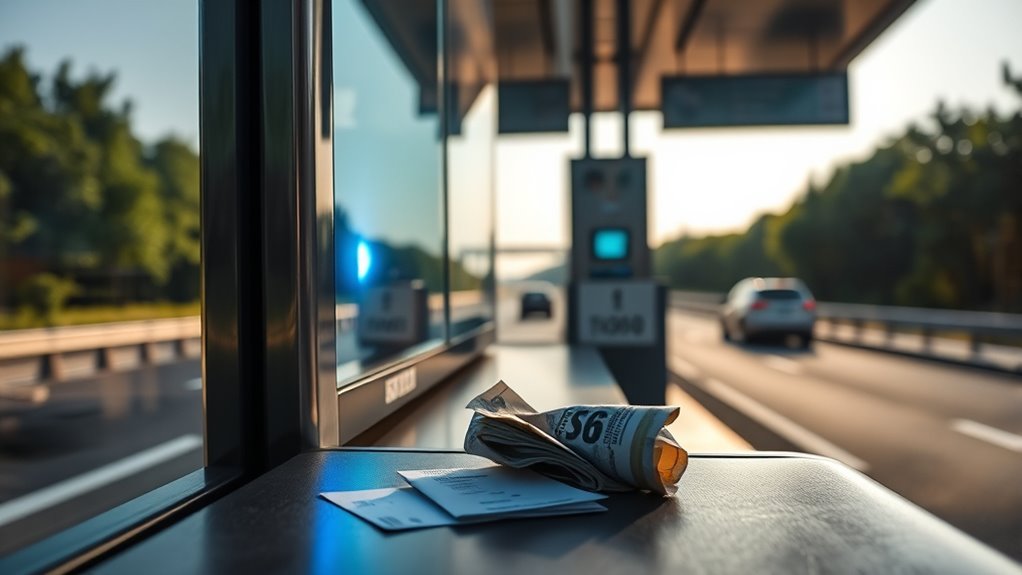When negotiating tolls in Europe, you can choose electronic systems or cash payments. Electronic toll collection uses transponders or license plate recognition for quick, hassle-free crossings, often with discounts for frequent travelers. Cash payments are straightforward but slower and may involve handling coins and bills. Preparing ahead, setting up electronic accounts, and carrying cash as backup can make your journey smoother. If you keep exploring, you’ll find tips on optimizing your toll experience across Europe.
Key Takeaways
- Electronic toll systems offer faster, seamless payments using transponders or license plate recognition, reducing delays compared to cash lanes.
- Cash payments are still accepted in many areas but can cause longer wait times and require local currency.
- Proper preparation includes setting up electronic accounts and carrying cash backup to avoid fines or delays.
- Electronic tolls often provide discounts for frequent travelers and feature dynamic pricing based on congestion.
- Staying informed about regional toll payment methods improves navigation and helps prevent violations across Europe.
Overview of Toll Systems in Europe

Europe’s toll systems vary widely across countries, making it essential for travelers to understand the different methods used. Some countries have traditional toll booths where you pay cash or card, while others rely on electronic systems. When approaching toll booths, practicing good toll booth etiquette helps guarantee smooth passage—stay in the correct lane, follow instructions, and be prepared to pay promptly. Many toll stations feature multilingual signage, which helps you navigate unfamiliar language barriers easily. In some regions, signs clearly indicate payment methods and lane options, reducing confusion. Recognizing these variations will help you plan better and avoid surprises. Whether paying with cash, card, or electronic devices, understanding the common practices across Europe enhances your travel experience and keeps your journey stress-free.
How Electronic Toll Collection Works
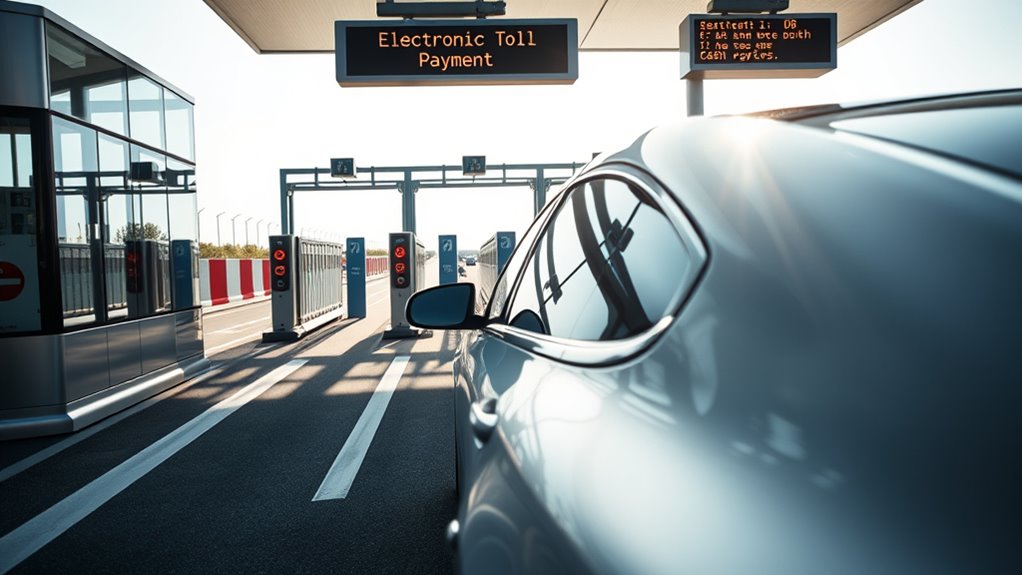
Have you ever wondered how electronic toll collection systems allow you to pass through tolls without stopping? These systems use transponders or license plate recognition technology to identify your vehicle automatically. When you approach a toll point, sensors detect your device, and the toll fee is deducted from your account or billed later. To maintain smooth toll booth etiquette, it’s essential to keep your transponder properly mounted and ensure your account has sufficient funds. Many countries offer electronic toll discounts for frequent travelers or those using dedicated lanes, making travel more affordable. This system eliminates the need to stop and pay cash, reducing congestion and delays. Understanding how electronic toll collection works helps you navigate tolls efficiently and enjoy a hassle-free driving experience across Europe. Additionally, store hours can impact your planning, especially if you’re traveling during holidays or outside regular hours. Being aware of payment methods accepted at toll points can prevent unexpected issues during your trip. Moreover, knowing about vehicle restrictions and regulations can help you avoid fines or delays during your journey. For example, some countries require specific vehicle documentation to use electronic toll systems smoothly, and being aware of potential personality test insights might enhance your overall travel experience.
The Role of Cash Payments at Toll Booths
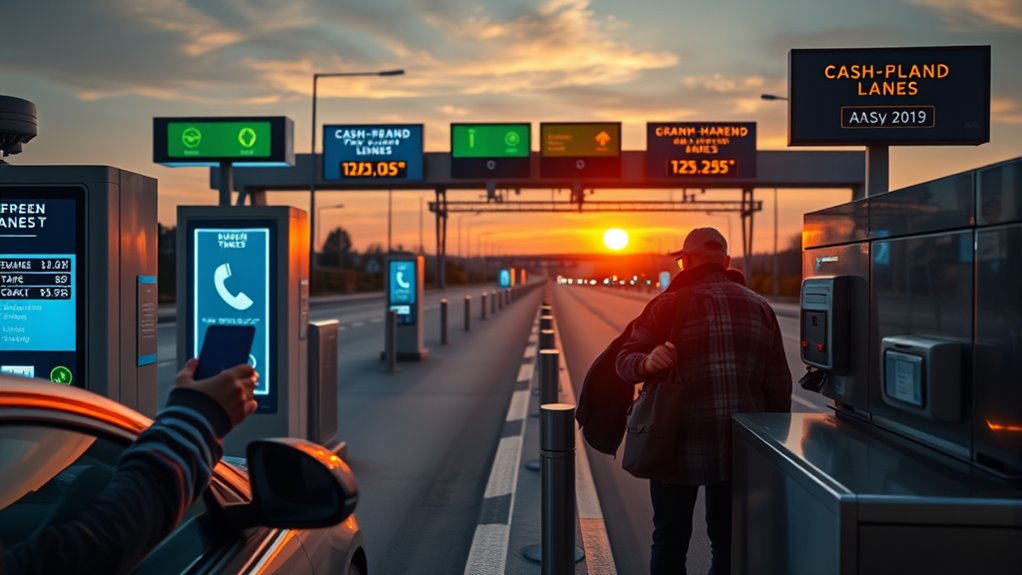
Cash payments are still accepted at many toll booths across Europe, so it’s important to know where you can pay this way. The payment process can be quick or slow depending on the location and how busy it is, so plan accordingly. Also, keep in mind that toll booths often require local currency and may not give change in foreign currency, which can affect your trip. Being aware of payment methods can help you better prepare for toll expenses during your journey. Additionally, understanding AI security measures in toll systems can ensure your payment data remains protected during transactions. Proper contrast ratio ensures your payment information is processed clearly and securely during electronic transactions. Awareness of modern infrastructure can also improve your experience and reduce delays at toll points.
Cash Acceptance Locations
Ever wonder where you can pay tolls with cash across Europe? Cash payments are accepted at various toll booth locations, but it’s essential to know the local toll regulations. Many countries still have traditional toll booths that accept cash, especially on older roads or in rural areas. Look for clear toll booth signage that indicates whether cash is accepted. In some regions, toll booths are equipped with attendants, making cash payments straightforward. However, in others, automated lanes may only accept electronic payments. Always check the signage before approaching a toll booth to avoid confusion or delays. Being aware of where cash is accepted helps ensure a smoother journey, especially if you prefer paying with cash or don’t have access to electronic toll systems. Additionally, understanding local toll regulations can help you prepare for different payment methods and avoid unexpected charges. Being familiar with toll collection methods can also help you plan your route more efficiently and prevent delays during your trip. Knowing the specific cash acceptance locations along your route can save time and reduce stress during your travels.
Payment Process Speed
While cash payments at toll booths can sometimes slow down the crossing process, their speed largely depends on the booth’s setup and traffic volume. Traditional cash lanes often require you to stop, exchange money, and wait for change, which can add delays. However, some booths now incorporate customer service technology like mobile apps or automated systems that speed up transactions. Using mobile apps linked to toll operators can streamline payments, reducing wait times and minimizing congestion. Cash payments remain straightforward but may be less efficient during peak hours. Your experience depends on how well the toll booth manages traffic flow and whether customer service options, such as quick cash lanes or digital payment support, are available. Additionally, understanding the payment process speed of different methods can help you choose the most efficient option for your crossing, making your journey smoother and faster. Incorporating aesthetic wall organization solutions can also help travelers locate payment stations more quickly and efficiently. Moreover, utilizing Volkswagen Tuning techniques can optimize vehicle performance, ensuring smoother acceleration and better fuel efficiency during long trips. Being aware of exfoliation benefits can also contribute to smoother skin, which might be beneficial during long journeys where comfort is key. To further improve your experience, exploring modern payment technology options can help you select the fastest and most convenient payment method.
Currency and Change
Paying with cash at toll booths requires you to have the right currency and enough change on hand, which can sometimes complicate the crossing. Different countries have varying toll pricing, and currency exchange rates can impact how much you pay. Keeping small bills and coins for tolls helps avoid delays. Be aware that some toll booths may not accept foreign currency, so exchanging money beforehand is wise. To simplify, carry a mix of denominations suited to each country’s toll systems. Here’s a quick comparison:
| Country | Accepted Currency | Common Toll Payment Method |
|---|---|---|
| France | Euro (€) | Cash or electronic |
| Italy | Euro (€) | Cash only or electronic |
| Switzerland | Swiss Franc (CHF) | Cash or electronic |
| Spain | Euro (€) | Cash or electronic |
Being prepared ensures smooth crossings and accurate toll pricing. Additionally, understanding toll payment methods can help you choose the most convenient option for your trip. Using local currency exchange services can also help you get better rates and reduce the risk of carrying too much foreign cash. Being aware of vetted toll options in each country can further streamline your journey. Furthermore, familiarizing yourself with the types of toll systems used across Europe can help you plan your payments more effectively. Recognizing the potential for currency fluctuations may also assist you in budgeting accurately for toll expenses.
Benefits of Using Electronic Toll Devices
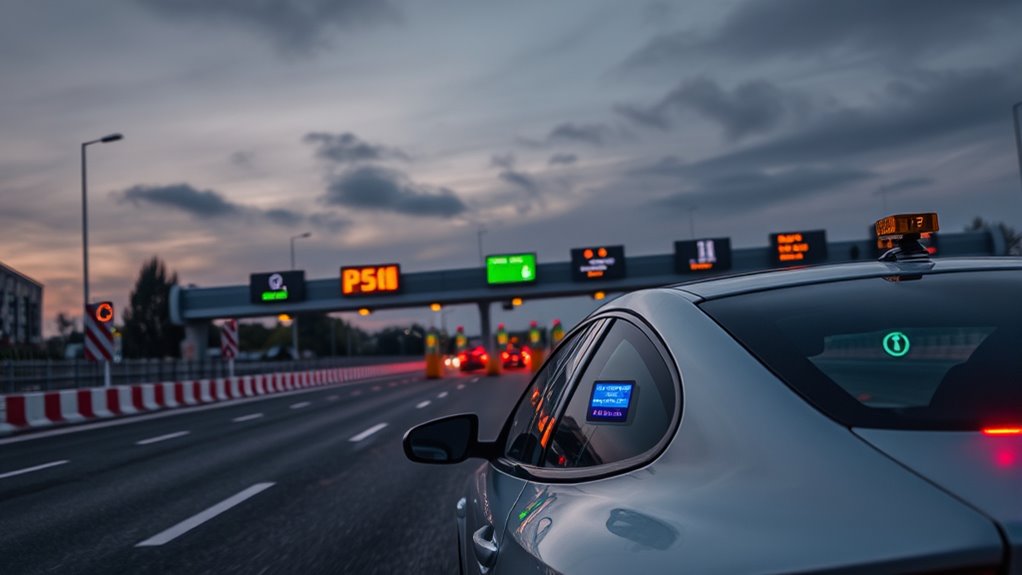
Using electronic toll devices makes your journey faster and more convenient, so you won’t have to slow down or stop at toll booths. They also eliminate the hassle of carrying cash or dealing with paper tickets. With these devices, you can enjoy a smoother, more efficient travel experience across Europe’s toll roads. Additionally, Halloween safety tips can help ensure a fun and secure celebration for everyone involved.
Speed and Convenience
Electronic toll devices substantially enhance your travel experience by making toll payments faster and more seamless. With these devices, you avoid long lines and delays at toll booths, saving you valuable time on the road. This speed means you can maintain a steady flow, reducing stress and improving overall driver safety. Plus, electronic tolls often operate without requiring you to stop completely, encouraging better toll booth etiquette—such as staying in your lane and being patient with other drivers. The convenience of quick transactions also means you won’t need to fumble with cash or cards, keeping your focus on the road. Overall, using electronic toll devices streamlines your journey, making your trips across Europe smoother, safer, and more efficient.
Reduced Payment Hassles
By adopting electronic toll devices, you eliminate the need to carry cash or search for the right coins at toll booths. This streamlines your journey, making payments quicker and hassle-free. Electronic systems automatically handle toll pricing based on vehicle classifications, ensuring accurate charges without manual intervention. You won’t need to stop or wait in lines, which reduces stress and saves time. Additionally, you avoid potential issues like incorrect change or missed payments, giving you peace of mind. These devices also adapt to different vehicle types, ensuring proper toll rates are applied. Overall, using electronic toll devices minimizes payment hassles, letting you focus on enjoying your trip instead of worrying about toll payments or orchestrating complex toll booths.
Drawbacks of Relying on Cash Payments
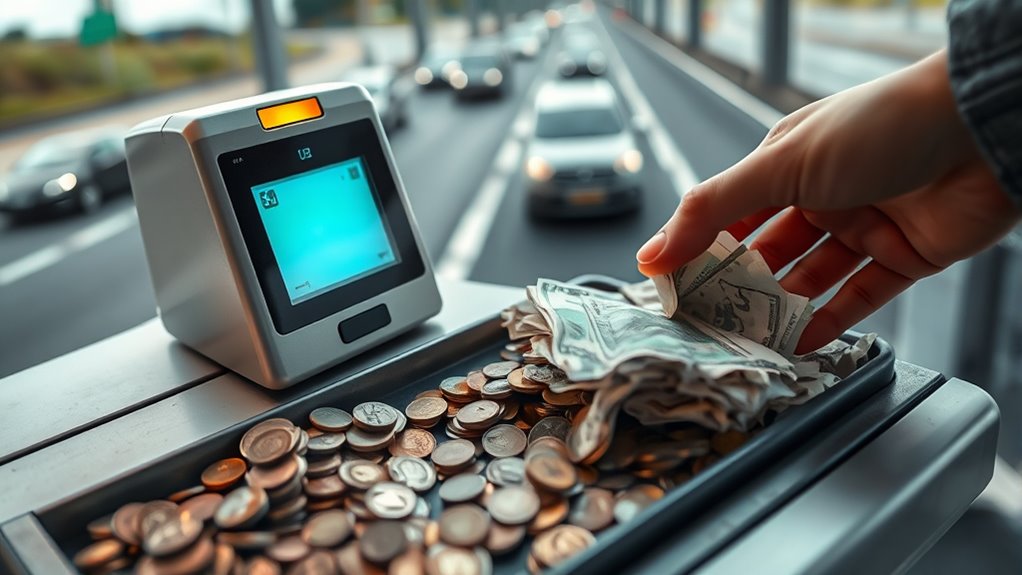
Relying on cash payments for tolls in Europe can be inconvenient, especially if you’re unprepared or unfamiliar with the local systems. Cash security is a concern since carrying large amounts of money makes you more vulnerable to theft or loss. Additionally, coin availability can be limited, causing delays or forcing you to search for specific denominations. Many toll booths no longer accept large bills, and coins may be scarce, especially in rural areas. This can lead to frustration and unexpected stops, disrupting your travel plans. Carrying sufficient cash also requires constant vigilance, and handling change can slow you down. Overall, cash payments can be unpredictable and less efficient compared to electronic options, which offer more security and convenience on the road.
Countries Leading in Electronic Toll Adoption
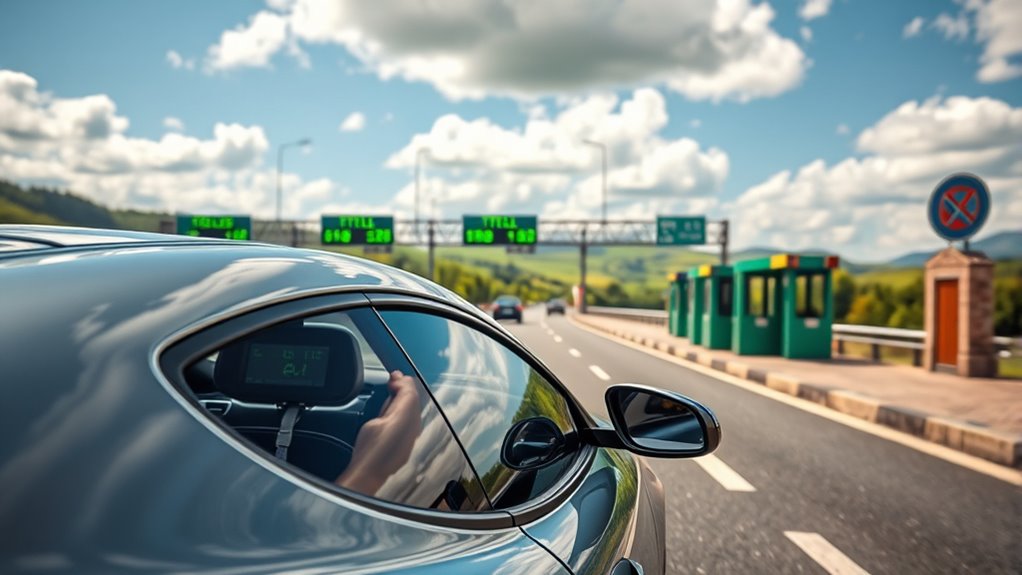
Norway, Italy, and Sweden are at the forefront of electronic toll adoption, making travel smoother and more efficient. Norway’s digital toll system eliminates the need for cash, while Italy’s extensive electronic network simplifies payment across many routes. Sweden’s automated payment system further streamlines toll collection, setting a high standard for other countries to follow.
Norway’s Digital Toll System
Norway has established itself as a leader in electronic tolling by implementing a highly efficient digital system that streamlines the collection process and reduces congestion. You don’t need to stop at toll booths, which means fewer delays and smoother drives. Instead, your driver responsibilities include ensuring your vehicle is registered correctly and adhering to toll payment rules. It’s important to follow toll booth etiquette by maintaining a safe distance and respecting electronic signage. Norway’s system uses automatic license plate recognition, making toll collection seamless. Here’s a quick overview:
| Aspect | Benefit | Your Responsibility |
|---|---|---|
| Digital System | Reduces congestion | Keep vehicle info updated |
| Toll Collection | No stopping required | Pay fines if missed payment |
| Ease of Use | Convenient and fast | Follow toll rules |
Italy’s Electronic Toll Network
Italy’s electronic toll network exemplifies how modern technology can improve travel across busy highways. Instead of relying solely on toll booth signage, which can cause delays and confusion, Italy has adopted an electronic system that streamlines toll collection. As you approach toll stations, cameras and sensors automatically identify your vehicle, allowing for seamless passage without stopping. This reduces traffic congestion, especially during peak hours, and minimizes long lines at traditional toll booths. The digital infrastructure encourages faster, more efficient travel, making it easier to navigate Italy’s extensive highway network. By embracing electronic tolling, Italy sets a standard for smoother journeys, saving you time and hassle while maintaining effective toll collection across its busy roads.
Sweden’s Automated Payment System
Sweden leads the way in electronic toll adoption with its highly efficient automated payment system. As you drive, you’ll notice that tolls are seamlessly charged without stopping, thanks to advanced cameras and license plate recognition. Here’s what to expect:
- No toll booth etiquette needed—payment occurs automatically, reducing congestion.
- Vehicles are identified instantly, so ensure your license plates are clean and visible.
- If you encounter issues, roadside assistance is quick to respond, minimizing delays.
- Remember, the system encourages smooth lane changes and respectful driving near toll points.
This setup simplifies toll payments and minimizes hassle, making your journey more comfortable. Just stay aware of signs, follow lane markings, and trust the technology to handle the rest.
Costs and Fees Associated With Toll Payment Methods
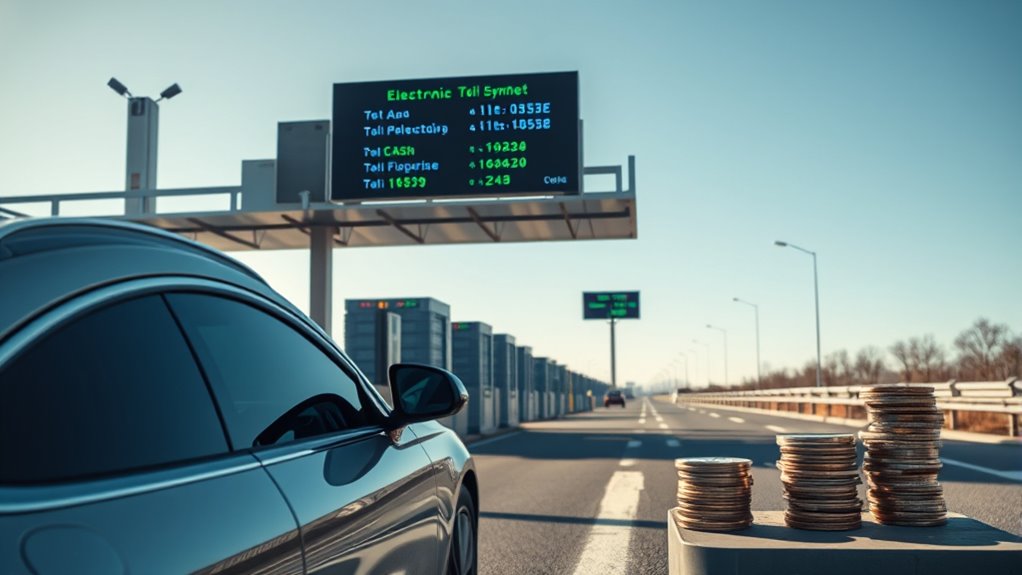
Understanding the costs and fees associated with toll payment methods is essential for planning your trip across Europe. Toll pricing varies widely by country and road type, often influenced by vehicle weight, emissions, or distance traveled. Electronic toll systems may charge a one-time fee for device registration or monthly service fees, while cash payments typically avoid these costs but may include toll booth surcharges. Fee structures differ: some countries use flat rates, while others base charges on vehicle class or toll zone. Be aware that hidden fees, such as currency conversion charges for international cards, can add to your costs. Comparing these toll pricing models helps you choose the most cost-effective payment method, reducing surprises and ensuring smoother travels across European toll roads.
How to Prepare for Toll Payments During Your Trip
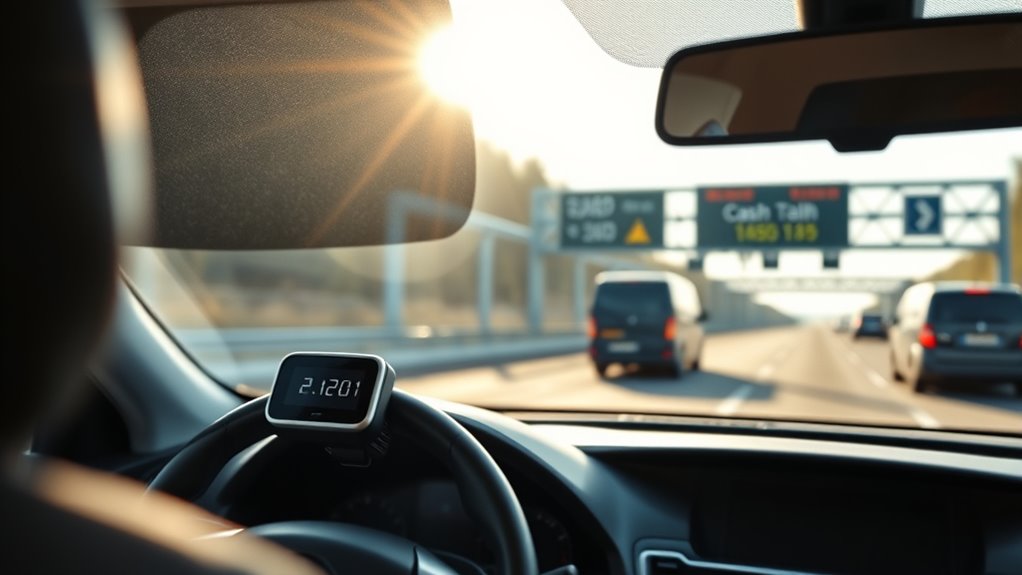
Preparing for toll payments before hitting the road can save you time and money during your trip. To stay prepared, consider these steps:
- Research toll zones and payment options along your route to avoid surprises.
- Ensure your insurance covers potential parking fines or toll violations.
- Set up electronic toll accounts if available, so payments are automatic.
- Carry some cash as a backup in case electronic payment options fail.
Knowing your payment methods helps prevent delays and accidental violations. Keep in mind that unpaid tolls can lead to parking fines or additional penalties, so staying organized is key. Confirm your insurance coverage for toll-related incidents, ensuring you’re protected. Proper preparation minimizes stress and keeps your trip running smoothly.
Tips for Switching Between Payment Methods
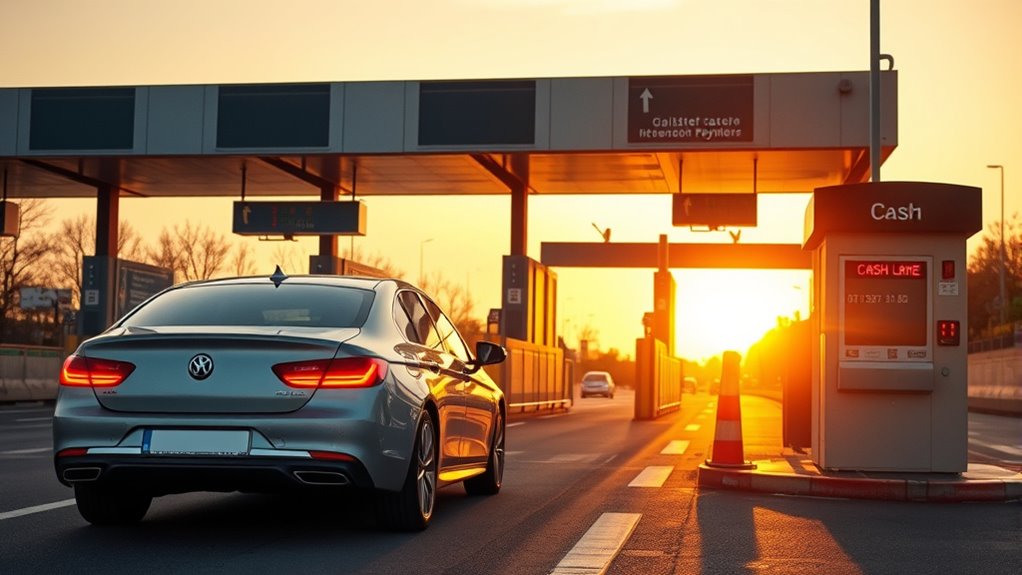
Switching between different toll payment methods during your trip can be straightforward if you stay organized. Always watch for toll booth signage to identify accepted payment options quickly. When approaching a toll, check if you can use alternative payment methods like electronic tags or digital apps instead of cash. Keep your payment devices handy to avoid delays. If you switch from electronic to cash, ensure you have enough change or cash on hand. Use this table as a quick guide:
| Payment Method | Tips |
|---|---|
| Electronic | Keep your device charged and updated. |
| Cash | Carry small bills and coins for flexibility. |
| Mixed | Be prepared for both options at different booths. |
Staying alert and prepared guarantees smooth transitions between payment methods.
Future Trends in European Toll Infrastructure
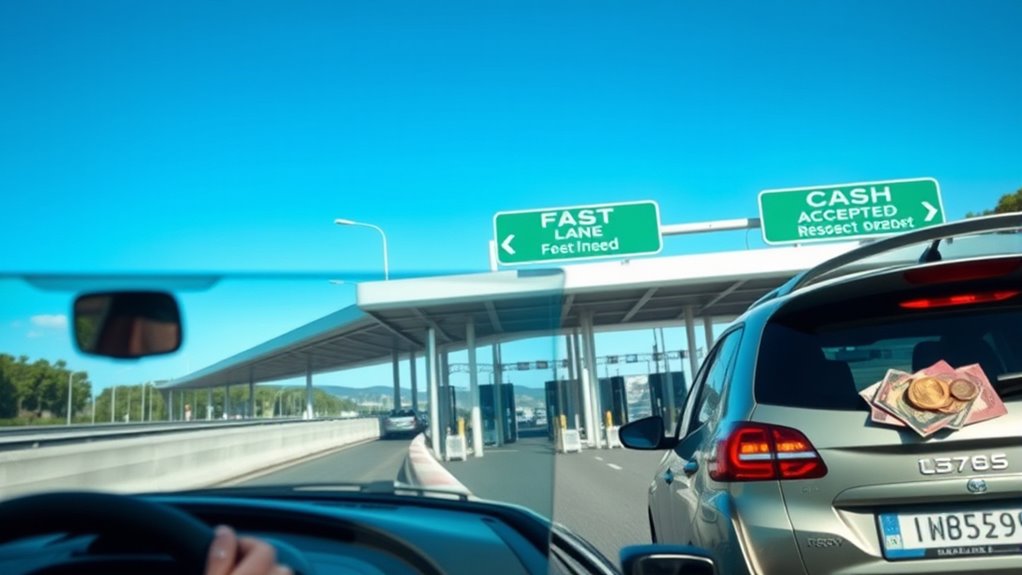
European toll infrastructure is rapidly evolving, driven by advancements in technology and a push toward more sustainable transportation. Expect toll systems to become more integrated, with digital platforms providing real-time toll pricing updates. Automated toll collection will enhance flow, minimizing delays. Future driver regulations will likely focus on eco-friendly practices, influencing toll pricing strategies. Here are key trends to watch:
- Increased adoption of electronic tolling across borders.
- Dynamic toll pricing based on congestion and vehicle emissions.
- Greater emphasis on seamless payment options, reducing cash reliance.
- Stricter driver regulations promoting eco-driving behaviors.
These changes will make toll navigation smoother, more efficient, and aligned with Europe’s sustainability goals. Staying updated on these trends helps you plan routes effectively and comply with evolving driver regulations.
Frequently Asked Questions
Are There Apps to Help Travelers Track Toll Costs Across Europe?
You’re wondering if there are toll cost apps to help with European toll tracking. Yes, many apps exist that can simplify this, showing you toll costs across different countries and routes. These toll cost apps help you plan your budget, avoid surprises, and stay informed about toll fees while traveling. Using these tools guarantees you manage your expenses efficiently and focus on enjoying your trip without worrying about toll payments.
How Do Toll Systems Differ Between Eastern and Western Europe?
You’ll notice that toll systems differ between eastern and western Europe. Western countries often have toll fee structures based on distance or type of vehicle, with multiple payment methods like electronic tags, credit cards, or cash. Eastern Europe may rely more on flat fees or vignette systems, requiring you to purchase a pass beforehand. These differences affect how smoothly you can pay and plan your route across these regions.
Can I Use My Home Country’S Electronic Toll Device in Other Countries?
You might wonder if your home country’s electronic toll device works across borders. It’s important to check international toll compatibility before you travel, as cross border toll devices aren’t always universally accepted. Some countries require specific transponders, so using a device from your home country may not guarantee access in others. To avoid surprises, research each country’s toll systems and consider renting or purchasing compatible transponders for seamless travel.
What Are the Penalties for Missing Toll Payments or Incorrect Fees?
If you miss toll payments or pay incorrect fees, you might face late fee penalties that increase over time. Additionally, authorities can impose legal consequences, such as fines or vehicle registration holds. It is crucial to pay tolls promptly to avoid these issues. Always double-check your toll charges and keep receipts to prevent misunderstandings or disputes, ensuring you stay compliant and avoid unnecessary penalties during your travels.
Are There Any Upcoming Changes in Toll Regulations or Technology Standards?
Thinking about future regulation updates and technology standard shifts, it’s wise to stay alert. Authorities are continuously refining toll systems, possibly moving toward more integrated electronic solutions and contactless payments. These changes aim to streamline travel and reduce congestion. Keep an eye on official announcements, as upcoming updates may introduce new standards or methods, making your journey smoother and more efficient, like a well-oiled machine ready to roll.
Conclusion
Finding your way through Europe’s tolls can be simple and stress-free when you choose the right method. By embracing electronic tolls, you’ll enjoy effortless expedience, economy, and ease on your journey. Ditch the delays of cash and immerse yourself in a smoother, safer, and smarter travel experience. Prepare properly, switch seamlessly, and stay ahead of the evolving toll trends. With a little planning, your European adventure becomes an enjoyable escape, free from fuss and frustration.
